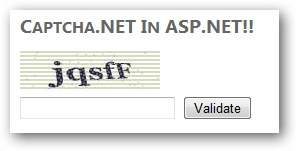
Using CAPTCHA was never easy for me before I got a class from an unknown user on a community forum post. I have just re-used the class to get my work done. The class is extremely easy to use and let you incorporate the CAPTCHA into your application in just few lines of code.
You can set the height and width of the CAPTCHA image while initializing the CAPTCHA class. The CAPTCHA image generated from the class can be set to the image control directly or it can be save to the local path and then set to the image control. For this example I am saving it to the local path and then set to the image control. And the CAPTCHA image code generated by the class is automatically set to the session variable named CaptchaCode.
Time to get some hand on it
On the page get an image control to display CAPTCHA image, a textbox where user will enter the CAPTCHA text and a button when clicked, we can check and validate if the code entered is correct or not. Plug the DLL in your ASP.NET project and go to the Page_Load event. Here we will generate the image of the height and width we wish to have for out CAPTCHA image and then save the image to the CaptchaImages folder with the random image code generated. The code on the Page_Load event goes like this:
protected void Page_Load(object sender, EventArgs e)
{
if (!Page.IsPostBack)
{
CaptchaImage cImage = new CaptchaImage(CaptchaImage.generateRandomCode(), 140, 40);
cImage.Image.Save(Server.MapPath("~\\CaptchaImages\\" + Convert.ToString(Session["CaptchaCode"]) + ".jpg"), ImageFormat.Jpeg);
CaptachaImage.ImageUrl = "~\\CaptchaImages\\" + Convert.ToString(Session["CaptchaCode"]) + ".jpg";
cImage.Dispose();
}
CaptchaCode = Convert.ToString(Session["CaptchaCode"]);
}
Before you can use the above code, declare a public variable which I have used to hold the value of the CAPTCHA code. I named it CaptchaCode. You can name it whatever you like it. We will be using this variable later to check it against the user input. Hit F5 to start and test your application. If everything is in place and you will be able to see the below output.

To check if the user enters the correct CAPTCHA code, we must have an event on button click which will validate the user input and prompt the user if CAPTCHA code is correct or incorrect. The code on the button click is:
protected void btn_Validate(object sender, EventArgs e)
{
if (CaptchaCode == txt_ccode.Text)
{
ClientScript.RegisterClientScriptBlock(typeof(Page), "ValidateMsg", "<script>alert('You entered Correct CAPTCHA Code!');</script>");
}
else
{
ClientScript.RegisterClientScriptBlock(typeof(Page), "ValidateMsg", "<script>alert('You entered INCORRECT CAPTCHA Code!');</script>");
}
}
The above code will check the CAPTCHA code entered by the user and check against the CAPTCHA code we previously saved in the session variable (CaptchaCode). If the validation is a success, user will get the message notifying him that he enters correct CAPTCHA code or the error message otherwise.
And that’s it, we have successfully implement a CAPTCHA in our ASP.NET application. So, here are few things we can do with this CAPTCHA library:
- Set image height and width.
- Saves the image to the local path.
- Automatically sets the generated CAPTCHA code to the application session.
I have build the sample project in ASP.NET 4.0, if you wanted to use the library in ASP.NET 3.x, then compile the project with lower version of ASP.NET and it will work perfectly. The below zip file contains both the projects.
Download: Captcha.NET.zip (377.63 kb)

